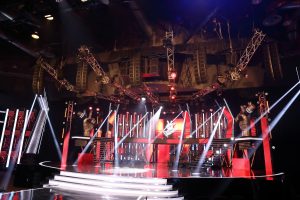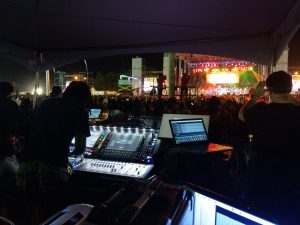DiGiCo Brings New Elements to South Africa’s Broadcast of The Voice ; Provides Consoles to Caribbean-Based Distributor
Story Highlights
The talent show phenomenon that is The Voice is now in its third season in South Africa and is bringing a brand-new audio experience to its studio audience, courtesy of L-ISA Hyperreal Sound technology by L-Acoustics and DiGiCo mixing consoles, provided by the show’s full technical supplier, Mutli-Media. In addition, Trinidad and Tobago-based Rent A Amp Sound Co (RAA) took delivery of an SD10 and SD12, the first DiGiCo consoles to permanently reside in the Caribbean.
 The Voice in South Africa
The Voice in South Africa
Multi-Media has worked with The Voice since the popular competition hit African soil four years ago. During this time, the company has grown and become more involved in live events. At the beginning of this year, it decided the time was right to invest in a top-end audio system, initially purchasing 30 L-Acoustics Kara, 12 SB18, four KS28, and seven LA12X amplified controllers, adding a further 18 Kara, four SB18 and five LA12X for the Mosaiek Teatro L-ISA configuration.
Early in his career, Multi-Media audio engineer Adriaan van der Walt recognized the limitations of stereo systems when trying to create a natural sounding mix. He became interested in how technology would develop to achieve a closer representation of how sounds are perceived by the human ear.
“I always jumped at the opportunity to work on quadrophonic and surround shows,” he says. “These were few and far between and some had greater levels of success than others. There was generally very little correlation between the setup in a studio and a large format PA system – it was really hit and miss! Then L-ISA caught my attention and I knew it would be a game-changer. L-Acoustics is a brand I trust and is always leading edge, setting trends and standards for the rest of the industry to follow. For me, moving to L-ISA was a no-brainer. I knew it would have huge benefits for a strong production like The Voice. When I presented the idea to the production team, they were convinced, too.”
Van der Walt and DWR’s Chris Pugh traveled to the manufacturer’s head office near Paris for an extensive four-day L-ISA training session. “It was very informative with a great deal of information to absorb, but the friendly and welcoming spirit that is present at L-Acoustics made it a special experience for me,” says Pugh. “I had dreamed of visiting L-Acoustics for 15 years and Adriaan and I loved every moment. We couldn’t wait to get back to South Africa to get started.”
The Mosaiek Teatro configuration sees five arrays of nine Kara each, positioned across the width of the stage as a Scene system. The KS28 subs are flown centrally, providing seamless coverage across the venue. Six Kiva II per side act as the Extension system and provide a wider panorama to the audio experience. Front fills comprise two X12 and, due to the width of the venue, there are an additional two ARCS WiFo flown per side to cover the outer sides of the venue. For stage monitoring, Multi-Media’s Simon Panos has used two X12 flown in the lighting grid and two X12 on the side of the stage.
Control is via a DiGiCo SD10 running the latest firmware. “It has a couple of new features that tie L-ISA and DiGiCo together,” says van der Walt. “The configurability of the SD Range is incredible. I set it up so that, in no more than three button pushes, I can be anywhere I need to be and do anything I need to do. Of course, it takes a bit of time to lay it all out and program it but, once you are in that operation mode, it really is a breeze to work on it.”
The DiGiCo system integrates Waves Multi-Rack, L-ISA Controller, Multitrack Recording and a busy Optocore backbone. “There was a lot of routing and insert patching that had to happen in the background,” he said. “We almost managed to max out the first Optocore loop – there are only 40 audio paths left out of 500.”
For van der Walt, the SD10 is an extension of himself with the console’s layout going hand-in-hand with his thought process: “That’s the beauty of it; once you’ve laid it out, it becomes an extension of your thoughts because you don’t have to tap around to get where you need to be. You think something, you tap once or twice, and you are there.”
The Voice is a complex and busy show, sometimes with only 15 seconds between performances and van der Walt is able to jump from one to the next with great ease: “The way the SD10 recalls fader banks over the entire console with just a Snapshot is truly amazing. We have rehearsed the show so much that it’s really just about recalling Snapshots and adding fine adjustments during the live broadcast.”
While there are familiarities in how the audio system is set up, the approach to mixing is, says van der Walt, a departure from what he is used to: “The experience means applying yourself in a new way. Your creative input becomes more valuable with L-ISA. It gives you the opportunity to interpret the music and place things where you think they should sit spatially. It’s incredible how this, in turn, affects the mix; the possibilities are endless.”
In the weeks leading up to the first sound check van de Walt spent many a night awake, imagining what they were going to do with, amongst other things, spatial placement and room engine configuration.
“The approach on The Voice is to create a pocket in the mix which surrounds and supports the talent’s vocal abilities,” van der Walt explains. “My traditional route was to make use of sub-groups; either for parallel compression for a fuller sound on drums, or to use side-chain compression on groups for guitars or keyboards. Naturally there was some compromise on how these groups sounded – to make space for the vocals to sit.
“I’m finding that I don’t have to do things on the console in a traditional way, or have to work so hard on the console to get the separation I want, as a lot of that is being achieved by L-ISA technology, freeing up space and providing tonal separation that I’ve never had before. Now, I listen with an open mind to put a mix together, whereas before I had to work hard at EQ and dynamics and overlaying things with Groups. I can push the vocals back into the mix and still hear them clearly, without losing the finer nuances of something like the guitars or keyboards. It really sounds like there is more resolution and depth associated with each object within the immersive environment, definitely more room to move.”
The integration of different brands and different technologies has pushed the system beyond what they had ever have imagined.
“L-ISA is new technology and we feel it is the future of sound,” adds de Lancey. “It really holds the audience. For the first time, we can create a scene using speakers. All 96 objects can be placed virtually anywhere in that space so you can hear where the instruments are coming from, where they are positioned on stage. If a vocalist were to walk up and down the stage, we can move the vocal to follow the artist. The system ties in what you are hearing with what you are seeing; now you know exactly where the artist is performing from.”
In a recent interview with South Africa’s Entertainment Technology magazine, finalist Anslin Gysman comments: “Keeping in mind that this is a first for South Africa and The Voice globally, it is an absolutely amazing opportunity for the talent participating in this season of the show. We have become used to working with a range of sound systems, but L-ISA is going to provide us with a better opportunity to showcase our vocal ability and also to give the audience a more exhilarating, emotional and personal experience.”
 Caribbean’s Rent A Amp
Caribbean’s Rent A Amp
The SD12’s first outing was on the I Am Legend concert at the end of April, which attracted an estimated 28,000 audience. Headlined by Jamaican musician Buju Banton, this was the follow up to his Long Walk to Freedom concert in March which marked his release from an eight-year jail sentence and his return to the Caribbean music scene. The console was deployed for local artists Ziggy Ranking, Ataklan, Isasha, and Kes the Band, plus Caribbean artists Wayne Wonder, Koffee, and Luciano, as well as Banton himself. With both the SD12 and SD10 also booked for the Tobago Jazz Festival just a couple of days later, RAA’s decision to invest in DiGiCo was immediately justified.
“Both RAA and artist engineers used the SD12 during the I Am Legend concert, with the RAA engineers having been trained by DiGiCo’s Dave Bigg, who flew over the week before the show,” recalls Fabien Bareille, VP AMR. “Setup was done during soundcheck for each band and saved to the console. RAA’s engineers enjoyed mixing on the SD12 and the artists’ engineers were pleased with the results, too.
“As an added bonus, Dave stayed for the concert to provide support. We didn’t really need him, as everything went very well, but having him there gave the RAA team a real sense of comfort.”
“It was fantastic to have Dave around for the first event,” adds RAA’s Frank Agarrat. “His knowledge was invaluable, and he was able to point us in the right direction from time to time.”
For the Tobago Jazz Festival, both consoles were deployed with the SD12 and SD10 at front of house and monitors for Tony Braxton and the SD10 for Michael Bolton’s monitors mix. A basic 56 input was used for all the bands, with a mixture of mono and stereo channels, and the shows were recorded from the SD12 via MADI.
“As engineers travel and get used to the quality of DiGiCo they continue to be increasingly requested,” Agarrat continues. “The SD12 is in a price bracket that is affordable for rental companies like RAA that work throughout the Caribbean and service festivals that involve international artists”
“A lot of the engineers who have found out about DiGiCo arriving in the Caribbean have asked us to arrange a DiGiCo seminar as soon as possible,” concludes Bareille. “We hope Dave will be OK for a second visit to Trinidad sometime before the end of the year!”
The next outing for RAA’s DiGiCos is the St Kitts Music Festival at the end of June, where Ella Mai has requested the SD12 for front of house and the SD10 for monitors.
